How Do You Know What Weight of a Blanket to Get for a Horse
Horse Blanketing Guide
How to Choose & Size a Stable or Turnout Rug
Have you lot always wondered, "Should I blanket my horse?" or "How do you mensurate a equus caballus for a blanket?" These are often asked questions from equus caballus owners striving to provide the highest level of care for their equine companions. Use this guide to acquire all nearly blanketing choice and sizing, including choosing turnout versus stable blankets, selecting make full weight, and measuring your horse for the perfect size.
What Type of Blanket Does My Horse Need
Equally you begin on your journeying to find the perfect blanket for your horse, it is important to understand the unlike types of blankets. Depending on where your equus caballus spends their time, either a sheet, turnout blanket, or stable blanket may be more advisable for them.

Sheets vs. Blankets
Sheets are articles of horse habiliment that accept no fill, or insulation, in them. Some are waterproof for lightweight coverage during the winter months while others can exist made from cotton blends for breathability during the warmer times of the year. Horse sheets are a great selection for moderate climates where horses need protection from the elements just don't need boosted warmth. They are also suitable for clipped horses who need coverage during the solar day.
Horse blankets have fill between the outer and inner layers to provide the horse boosted warmth during winter. Blankets can come in a variety of weights to accommodate horses living in different climates.
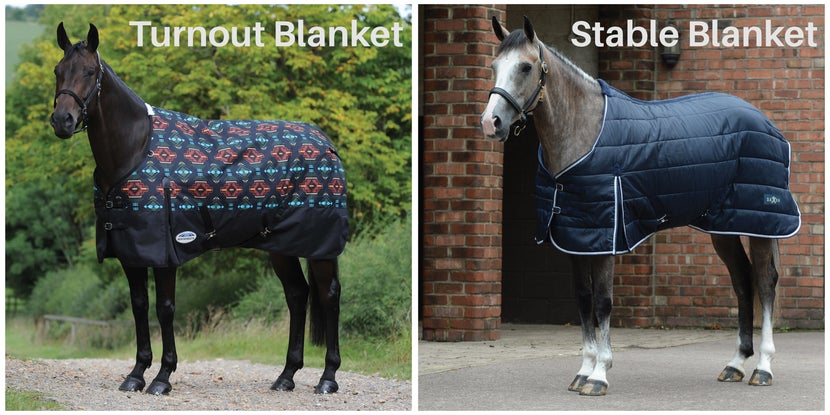
Turnout Blankets vs. Stable Blankets
Turnout blankets, besides known as turnout rugs, are designed to withstand the elements, keeping your equus caballus warm and dry. They usually feature waterproof outer material, varying in denier and level of make full. The denier (usually 600D or 1200D) determines how thick the fabric is, with higher deniers generally being more durable and less prone to ripping. Turnouts are most appropriate for horses who either live or spend fourth dimension outside.
Stable blankets are similar to turnout blankets, except they are not waterproof. For this reason, they are ideal for horses that alive inside. Available in different deniers and fills, you can pick the fashion based on how hard your horse tends to exist on blankets besides as how much warmth they demand.
When Exercise Horses Demand Blankets?
Blanketing Factors
Many horse owners wonder if and when their equus caballus or pony needs a blanket. When to blanket your horse depends on multiple factors, including:
- Living Conditions: Horses with a stall or shelter may exist fine with their wintertime coat. However, if they do not accept full protection to escape the common cold, information technology may be best to consider a blanket.
- Geography: The temperature of the expanse where your horse resides every bit well equally the climate they are accepted to can affect how they answer to colder temperatures. For instance, a 30-degree night will feel unlike to a equus caballus that'south used to living in California than one living in New York.
- Age: As horses get older, they can have a harder time keeping warm as well equally keeping weight on through the winter months. This means senior horses may need heavier blankets than their younger counterparts.
- Body Condition: Information technology takes a lot of free energy for horses to keep themselves warm in colder climates. Similar to older horses, hard keepers may also need heavier blankets than easy keepers.
- Hair Coat: An unclipped horse may not need any blankets since they can grow the necessary hair coat to stay warm, just a partially or fully clipped horse will need a blanket when the temperature drops. Blanketing an unclipped horse tin also exist beneficial if yous are looking to keep their hair coat to a minimum.
- Traveling: Depending on where y'all are traveling, it may be advisable to blanket during travel. Similar to the geography factor, if the equus caballus is non accepted to a colder climate, they might exist susceptible to cold in the trailer. Furthermore, if the horse is fully clipped or has a light coat, they may need a sheet or a blanket to go on warm during the colder months of travel. Keep in mind how much ventilation your trailer has when deciding on a coating. Trailers that permit in more air, such as stock trailers, may crave blanketing due to cold winds. Whereas trailers with less ventilation or with multiple horses traveling together tin get a bit warmer, and you lot may want to use a lighter blanket on your horse. A good rule of pollex is to pack with a couple of unlike weight blankets so you can alter them depending on the weather.
Coating Weights
If you have decided to blanket your horse, you'll need to decide what weight of blankets to go along on hand. The weight of a equus caballus blanket refers to the amount of fill up, or insulation, it has. At that place are lightweight, medium, and heavy options with respective grams of fill up, varying from 0g to 450g.
- Lightweight: No fill to 150g of insulation. A skillful choice for keeping your horse dry in the rain and keeping them cozy in warmer climates.
- Medium Weight: 180g to 250g of insulation. Provides protection and warmth for colder climates.
- Heavy Weight: 275g to 450g of insulation. Ideal for very cold conditions with temperatures below freezing.
Coating Weight & Temperature Nautical chart
Deciding on what weight to coating your horse might seem like a daunting task, however, it is important to remember that a horse'due south coat is naturally meant to withstand temperatures below 30 degrees if they are not body clipped. Just because yous are cold, that doesn't mean that an unclipped equus caballus who has access to shelter and is an like shooting fish in a barrel keeper needs a heavyweight blanket in fifty-degree weather!
Below nosotros have created a temperature chart guideline for you lot to follow for blanketing clipped and unclipped horses. Consider blanketing factors and your equus caballus's own state of affairs to determine the correct coating weight.
| Temperature Range | Unclipped | Recently Clipped |
| fifty-60 degrees | Canvass as Needed | Lightweight |
| twoscore-l degrees | Lightweight | Light/Medium |
| xxx-xl degrees | Calorie-free/Medium | Medium/Heavy |
| 20-xxx degrees | Medium/Heavy | Heavy |
| Below xx degrees | Heavy | Heavy with Liner |
Parts and Features of Blankets
Along with the way and weight of the blanket, in that location are blanket parts and features to consider. Some features offer more protection against the elements while others get in easier to removie or put on the blanket. Read on to discover how some blanket parts and features may be improve for dissimilar horses or situations.
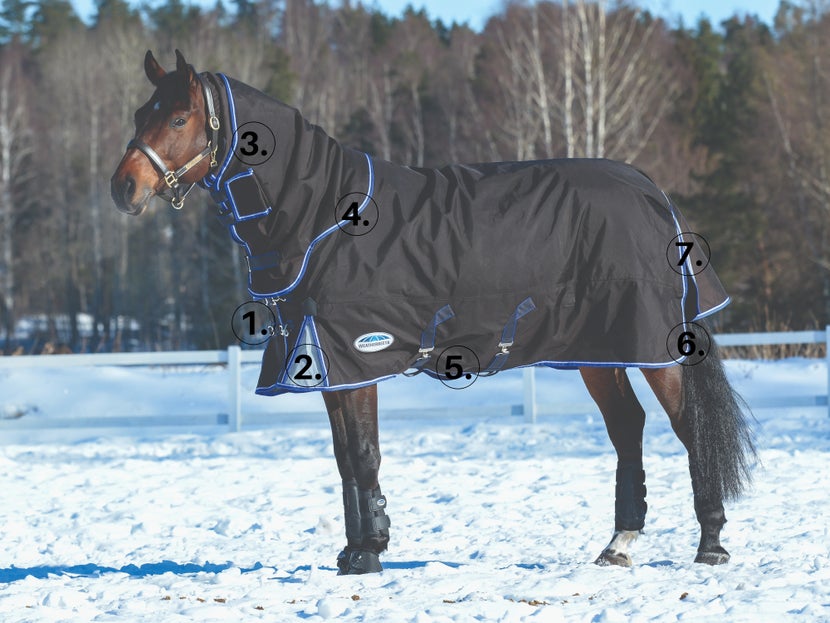
i. Front Buckles are adjustable and so you can achieve the perfect fit on your horse. Yet, there are blankets that have "surcingle" closures that will non let any adjustment. Some blankets may have standard buckles while others feature "quick-clips" that permit you to undo the buckles quickly and easily for convenience.
ii. Shoulder Gussets are standard on most blankets and are a must-have for horses with large shoulders. The additional fabric allows the shoulders to move comfortably and prevent rubbing as they walk, trot, or amble. Even horses with standard or small shoulders can benefit from shoulder gussets.
3. Neckpiece/Cervix Covers offer farther warmth and protection from the elements. Some adhere directly onto the blanket while others may exist incorporated into the coating itself, such equally a "combo" blanket. The removable neckpiece option is ideal for horses living in climates where the temperature tin vary profoundly during the winter flavor.
4. Neck Styles can vary among blankets; withal, the two most popular styles are standard neck and high neck. Standard neck blankets come upward right to a higher place the wither and typically have some padding or a fleece piece that prevents the blanket from rubbing on the horse's mane. High neck blankets come up nigh mid-neck and are a skilful option for horses with narrow shoulders and high withers. The college pattern reduces pressure on the withers, which prevents rubbing and keeps them comfy all winter long.
5. Abdomen Surcingles forestall the blanket from rotating on the horse'south barrel. Blankets tin come with i, 2, or three surcingles. Typically, the more surcingles, the more secure the blanket will be on the horse. This could be platonic for horses who like to escape from their blankets.
6. Leg Staps/Tail Cords help keep the coating from rotating on the equus caballus. They are typically made from rubberband and are removable and adjustable to fit a wide variety of horses. If a blanket does not accept leg straps, it may have a tail cord, which runs under the horse's tail and connects the finish of the blanket together. Tail cords piece of work similarly to leg straps but are not as secure.
vii. Tail Flaps can come in 2 sizes: standard and large. The do good of having a larger tail flap is that it offers the horse more protection confronting air current or rain. However, if your horse is on the smaller side, a large tail flap could be too large and a standard flap may be more appropriate.
What is Denier in Equus caballus Blankets?
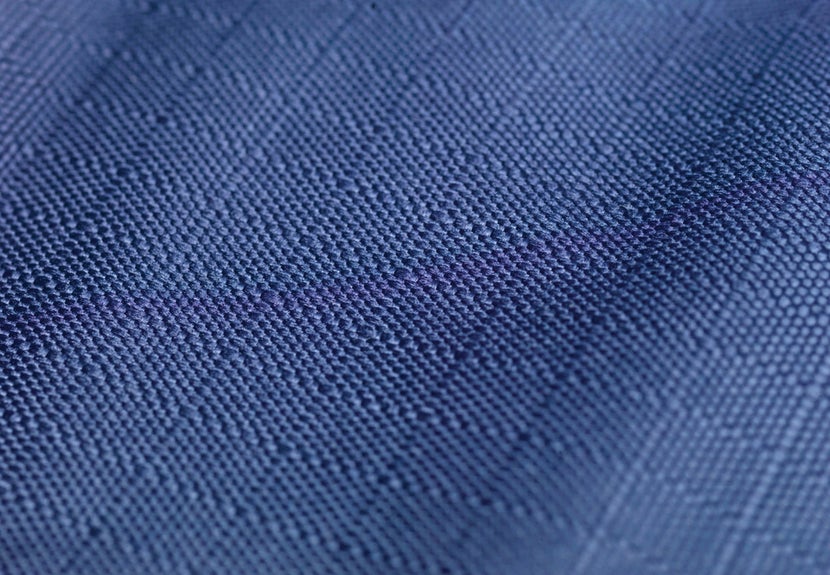
Denier refers to the thickness of each individual fiber used in the making of the blanket. Blankets with a higher denier count have thicker fibers and therefore are more resistant to violent and ripping. Some horses who are rough on their coating may need a college denier count to brand it through the winter season, while blanket-friendly horses tin get abroad with a lower denier.
The denier material, or fibers, can likewise influence how stiff and durable the blanket is. For example, ballistic nylon is stronger than polypropylene nylon which is stronger than standard polyester nylon. If you have a horse who is a blanket wrecker, choosing a higher denier with high-quality fiber is your best bet for making sure your blanket survives the wintertime.
Blanket Liners
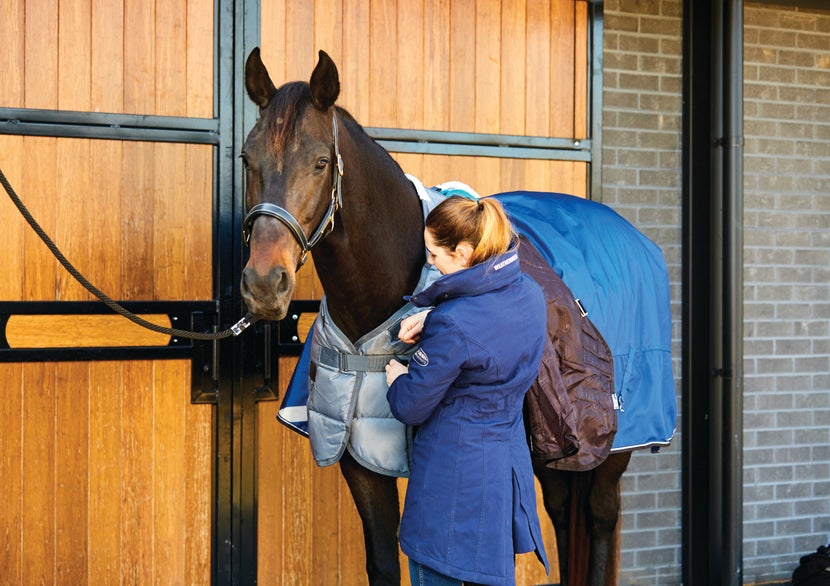
Blanket liners are layered underneath your existing blanket to provide additional warmth. They typically accept a lower denier and are lined with polyfill in a variety of different weights. The beauty of adding a liner is yous tin can turn your blanket from 1 weight to another without having to buy a new blanket. For case, with a 100-gram liner, you can transform a lightweight blanket into a medium weight and a medium weight into a heavy blanket. This versatility allows yous to blanket according to the weather you are experiencing.
Some brands, such as Horseware and Weatherbeeta, specifically build some of their blankets to exist compatible with liners. This allows you to prune in the liner so it doesn't shift around underneath the blanket, keeping your horse more comfortable.
How to Mensurate a Horse for a Blanket
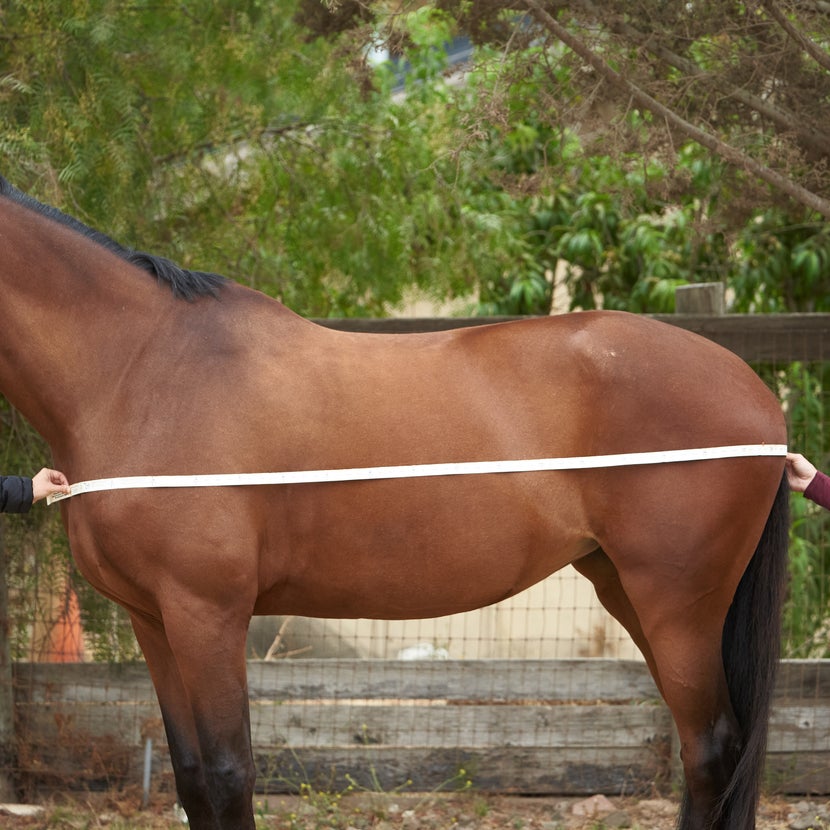
Measure out for Blanket Size in v Easy Steps:
- Grab a friend and soft material tape measurer.
- Place the cloth record measurer at the middle of your horse's breast.
- Unroll the tape measurer around the widest role of your equus caballus's shoulder and angle it upwardly to the farthest bespeak of the horse's buttock.
- Measure around to where the tail meets the buttock, approximately the middle of the tail.
- This should exist your equus caballus's coating size. If they are between sizes, it is usually a safe bet to round upwardly.
For more information on a measuring and sizing horse blankets, check out our complete how to measure out for a horse coating guide! For our visual learners, watch the video beneath to larn how to measure your equus caballus for a blanket, ensuring you purchase the right size for your horse every time.
How Should a Horse Blanket Fit?
A well-fitting blanket should cover your horse'due south trunk and still let them to move naturally. Evaluate these iii points on the blanket to decide if it is a good fit.
1. Shoulders: The front buckle closures should coincide with the point of the horse's shoulder, while the neckline should rest above the shoulder. You should exist able to run a paw along the chest and shoulders and not experience tension. If it is pulling along the shoulders then the blanket is likewise small, and if it is gapping so the blanket is too big.
2. Withers: Ensure that you can identify a mitt between the withers and blanket. A blanket that is too tight volition rub the withers and be uncomfortable for the horse.
3. Length: A blanket should cover the horse's barrel and flank and should end but below the elbow and stifle. A blanket that's too minor won't offering enough coverage, while a blanket that'south also big is hazardous and may cause the horse to get hung up.
How to Clean and Shop Horse Blankets
In one case blanketing season is over, it might be tempting to but leave your blanket hanging until side by side flavor. All the same, properly caring for your blanket can salve you lot from having a purchase a new blanket every year. Follow our helpful tips on how to easily clean and store your coating.
Cleaning Horse Blankets
To clean your blanket, first castor off any excess dirt or debris that has accumulated on the exterior. From in that location, you can either wash the blanket by hand or launder it at home. For either method, make sure you employ cool water or a cool wash cycle, and a blanket launder that is formulated to gently clean so it won't damage the waterproof coating. If you wash the blanket past hand, do not use a power washer, as it may impairment the waterproof layer. Once clean, hang the blanket to drip dry.
Storing Horse Blankets
Once the coating is clean and completely dry, neatly fold it into a breathable coating storage bag. The branded bag that your coating comes in offers great storage for after-season apply! Try to avoid storing your blanket in any areas that may become clammy or excessively hot.
Closing Thoughts
Nosotros promise this handy guide answered all of your blanketing questions! For any farther aid, feel gratuitous to contact our friendly customer service team.
Related Article
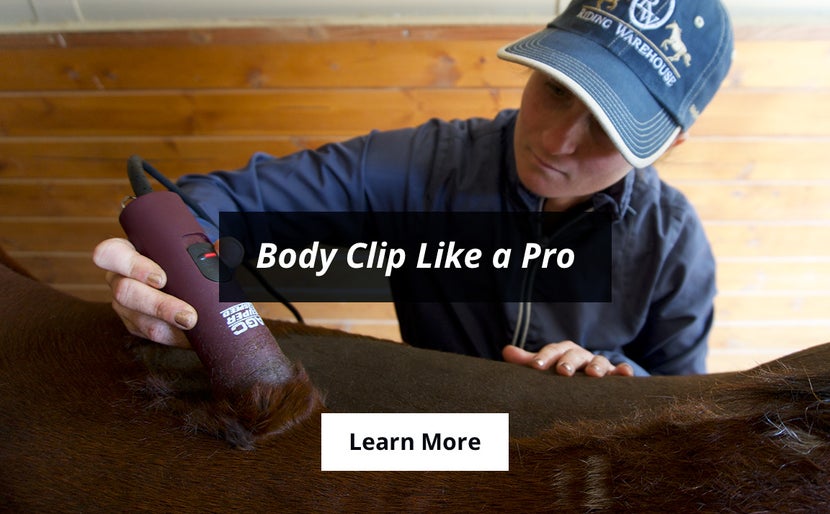
Source: https://www.ridingwarehouse.com/lc/training/horse_blankets_guide/how_to_choose_the_best_horse_blanket.html
0 Response to "How Do You Know What Weight of a Blanket to Get for a Horse"
Post a Comment